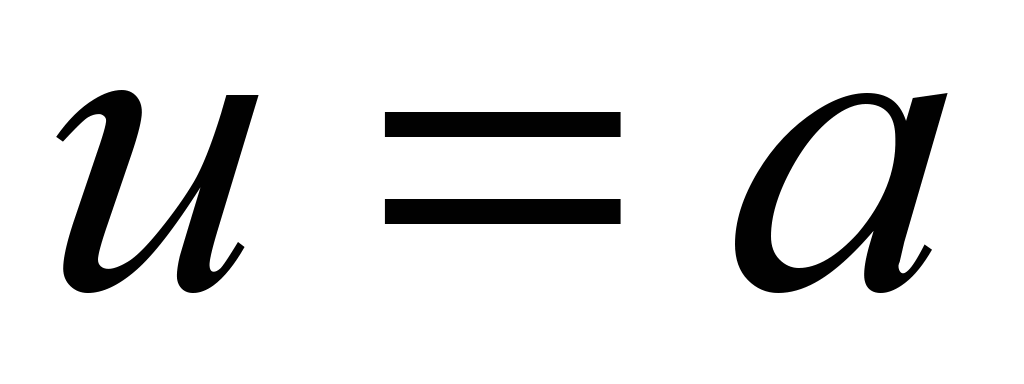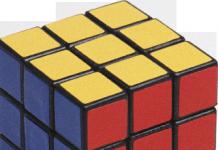1 °. Equations of the tangent plane and the normal for the case of explicit specification of the surface.
Consider one of the geometric applications of partial derivatives of a function of two variables. Let the function z = f (x;y) differentiable at the point (x 0; at 0) some area DÎ R 2... Let's cut the surface S, imaging function z, planes x = x 0 and y = y 0(fig. 11).
Plane X = x 0 crosses the surface S along some line z 0 (y), whose equation is obtained by substituting the original function into the expression z ==f (x;y) instead of X the numbers x 0. Dot M 0 (x 0;y 0,f (x 0;y 0)) belongs to the curve z 0 (y). By virtue of the differentiable function z at the point M 0 function z 0 (y) is also differentiable at the point y = y 0. Therefore, at this point in the plane x = x 0 to the curve z 0 (y) a tangent can be drawn l 1.
Carrying out similar reasoning for the section at = at 0, build a tangent l 2 to the curve z 0 (x) at the point X = x 0 - Direct 1 1 and 1 2 define a plane called tangent plane to the surface S at the point M 0.
Let's make her equation. Since the plane passes through the point Mo (x 0;y 0;z 0), then its equation can be written in the form
A (x - xo) + B (y - yo) + C (z - zo) = 0,
which can be rewritten like this:
z -z 0 = A 1 (x - x 0) + B 1 (y - y 0) (1)
(dividing the equation by -C and denoting ![]() ).
).
Find A 1 and B 1.
Tangent equations 1 1 and 1 2 have the form
respectively.
Tangent l 1 lies in the plane a , therefore, the coordinates of all points l 1 satisfy equation (1). This fact can be written as a system

Solving this system with respect to B 1, we obtain that. Carrying out similar reasoning for the tangent l 3, it is easy to establish that.
Substituting the values A 1 and B 1 into equation (1), we obtain the required equation of the tangent plane:
Line through point M 0 and perpendicular to the tangent plane constructed at this point of the surface is called its normal.
Using the condition of perpendicularity of a straight line and a plane, it is easy to obtain canonical equations normals:
![]()
Comment. The formulas for the tangent plane and the normal to the surface are obtained for ordinary, that is, non-singular, points of the surface. Dot M 0 surface is called special, if at this point all partial derivatives are equal to zero or at least one of them does not exist. We do not consider such points.
Example. Write the equations of the tangent plane and the normal to the surface at its point M (2; -1; 1).
Solution. Let us find the partial derivatives of this function and their values at the point M

Hence, applying formulas (2) and (3), we will have: z-1 = 2 (x-2) +2 (y + 1) or 2x + 2y-z-1 = 0- the equation of the tangent plane and ![]() - normal equations.
- normal equations.
2 °. Equations of the tangent plane and the normal for the case of implicit surface definition.
If the surface S given by the equation F (x; y;z)= 0, then equations (2) and (3), taking into account the fact that partial derivatives can be found as derivatives of an implicit function.
Definition 1 : The tangent plane to the surface at a given point P (x 0, y 0, z 0) is the plane passing through the point P and containing all the tangents constructed at the point P to all possible curves on this surface passing through the point P.
Let the surface s be given by the equation F (X, at, z) = 0 and point P (x 0 , y 0 , z 0) belongs to this surface. Let us choose some curve on the surface L passing through the point R.
Let X = X(t), at = at(t), z = z(t) - parametric equations of the line L.
Suppose that: 1) the function F(X, at, z) is differentiable at the point R and not all of its partial derivatives at this point are equal to zero; 2) functions X(t), at(t), z(t) are also differentiable.
Since the curve belongs to the surface s, the coordinates of any point of this curve, being substituted into the equation of the surface, will turn it into an identity. Thus, the identity equality is true: F [x(t), at(t), z (t)]= 0.
Differentiating this identity with respect to the variable t using the chain rule, we obtain a new identity that is valid at all points of the curve, including at the point P (x 0 , y 0 , z 0):
Let point Р correspond to the value of the parameter t 0, that is x 0 = x (t 0), y 0 = y (t 0), z 0 = z (t 0). Then the last relation calculated at the point R, will take the form
This formula is the dot product of two vectors. The first of them is a constant vector
independent of the choice of a curve on the surface.
The second vector is a tangent at a point R to the line L, which means that it depends on the choice of a line on the surface, that is, it is a variable vector.
With the introduced notation, the equality:
rewrite as.
Its meaning is as follows: the dot product is equal to zero, therefore, vectors and are perpendicular. Choosing all kinds of curves going through a point R on the surface s, we will have different tangent vectors constructed at the point R to these lines; the vector does not depend on this choice and will be perpendicular to any of them, that is, all tangent vectors are located in one plane, which, by definition, is tangent to the surface s, and the point R in this case it is called the point of tangency. The vector is the direction vector of the surface normal.
Definition 2: The normal to the surface s at the point P is the straight line passing through the point P and perpendicular to the tangent plane constructed at this point.
We have proved the existence of a tangent plane and, therefore, a normal to the surface. Let's write down their equations:
The equation of the tangent plane constructed at the point P (x0, y0, z0) to the surface s, given by the equation F (x, y, z) = 0;
Equation of the normal drawn at a point R to the surface s.
Example: Find the equation of the surface formed by the rotation of the parabola:
z 2 = 2p (y +2)
around the axis oy, calculate provided that the point M (3, 1, - 3) belongs to the surface. Find the equations of the normal and tangent plane to the surface at point M.
Solution. Using the rule for recording the surface of revolution, we get:
z 2 + x 2 = 2p (y +2) .
Substituting the coordinates of the point M into this equation, we calculate the value of the parameter p: 9 + 9 = 2p (1 + 2) ... Write down the final view of the surface of revolution passing through the point M:
z 2 + x 2 = 6 (y +2).
Now we will find the equations of the normal and the tangent plane by the formulas, for which we first calculate the partial derivatives of the function:
F (x, y) = z 2 + x 2- 6 (y +2):
Then the equation of the tangent plane takes the form 6 (x - 3) - 6 (y - 1) - 6 (z + 3) = 0 or x - y - z - 5 = 0;
Consider geometric applications of the derivative of a function of several variables. Let the function of two variables be given implicitly:. In its domain of definition, this function is depicted by some surface (Section 5.1). Take an arbitrary point on this surface ![]() , in which all three partial derivatives,, exist and are continuous, and at least one of them is not equal to zero.
, in which all three partial derivatives,, exist and are continuous, and at least one of them is not equal to zero.
A point with such characteristics is called ordinary point of the surface. If at least one of the above requirements is not met, then the point is called special point of the surface.
A set of curves can be drawn through a point selected on the surface, to each of which a tangent can be drawn.
Definition 5.8.1 . The plane in which all tangent lines to the lines on the surface passing through some point are located is called the tangent plane to this surface at the point .
To spend given plane it is enough to have two tangent lines, that is, two curves on the surface. These can be curves obtained as a result of sectioning a given surface by planes (Figure 5.8.1).

Let us write the equation of the tangent line to the curve lying at the intersection of the surface and the plane. Since this curve lies in the coordinate system, the equation of the tangent to it at a point, in accordance with Section 2.7, has the form:
![]() . (5.8.1)
. (5.8.1)
Accordingly, the equation of the tangent to the curve lying at the intersection of the surface and the plane in the coordinate system at the same point has the form:
![]() . (5.8.2)
. (5.8.2)
We will use the expression for the derivative of an implicitly defined function (Section 5.7). Then, ah. Substituting these derivatives in (5.8.1) and (5.8.2), we obtain, respectively:
 ; (5.8.3)
; (5.8.3)
 . (5.8.4)
. (5.8.4)
Since the obtained expressions are nothing but equations of straight lines in canonical form (Section 15), from (5.8.3) we obtain the direction vector ![]() , and from (5.8.4) -
, and from (5.8.4) - ![]() . Vector product will give a vector normal to the given tangent lines, and therefore to the tangent plane:
. Vector product will give a vector normal to the given tangent lines, and therefore to the tangent plane:

Hence it follows that the equation of the tangent plane to the surface at the point ![]() has the form (item 14):
has the form (item 14):
Definition 5.8.2
. Line drawn through a point ![]() surface perpendicular to the tangent plane at this point, called the normal to the surface.
surface perpendicular to the tangent plane at this point, called the normal to the surface.
Since the direction vector of the normal to the surface coincides with the normal to the tangent plane, the normal equation has the form:
 .
.
Scalar field
Let an area be given in space that occupies part or all of this space. Let a certain scalar quantity (number) be assigned to each point of this area according to some law.
Definition 5.9.1 . A region in space, to each point of which a certain scalar quantity is assigned according to a well-known law, is called a scalar field.
If some coordinate system is associated with the area, for example, a rectangular Cartesian one, then each point acquires its own coordinates. In this case, the scalar becomes a function of coordinates: on the plane -, in three-dimensional space - ![]() ... The function describing a given field is often called a scalar field. Depending on the dimension of the space, the scalar field can be flat, three-dimensional, etc.
... The function describing a given field is often called a scalar field. Depending on the dimension of the space, the scalar field can be flat, three-dimensional, etc.
It should be emphasized that the magnitude of the scalar field depends only on the position of the point in the region, but does not depend on the choice of the coordinate system.
Definition 5.9.2 . A scalar field that depends only on the position of a point in the region, but does not depend on time, is called stationary.
We will not consider nonstationary scalar fields, that is, time-dependent, in this section.
Examples of scalar fields include the temperature field, the pressure field in the atmosphere, and the altitude field above the ocean level.
Geometrically, scalar fields are often depicted using so-called level lines or surfaces.
Definition 5.9.3
. The set of all points in space at which the scalar field ![]() has the same meaning called level surface or equipotential surface. In the plane case for a scalar field, this set is called the level line or equipotential line.
has the same meaning called level surface or equipotential surface. In the plane case for a scalar field, this set is called the level line or equipotential line.
Obviously, the equation of the level surface has the form ![]() , level lines -. Giving in these equations the constant different meanings, we get a family of surfaces or level lines. For instance,
, level lines -. Giving in these equations the constant different meanings, we get a family of surfaces or level lines. For instance, ![]() (nested spheres with different radii) or (family of ellipses).
(nested spheres with different radii) or (family of ellipses).
As examples of level lines from physics, one can cite isotherms (lines of equal temperatures), isobars (lines of equal pressures); from geodesy - lines of equal heights, etc.
Namely, what you see in the title. Essentially, it is a "spatial analogue" the problem of finding the tangent and normals to the graph of a function of one variable, and therefore no difficulties should arise.
Let's start with some basic questions: WHAT IS a tangent plane and WHAT IS a normal? Many are aware of these concepts at the level of intuition. The simplest model that comes to mind is a ball with a thin flat piece of cardboard resting on it. The cardboard is located as close to the sphere as possible and touches it at a single point. In addition, at the point of contact, it is fixed by a needle sticking straight up.
In theory, there is a rather ingenious definition of a tangent plane. Imagine an arbitrary surface and the point belonging to it. Obviously, a lot of spatial lines that belong to this surface. Who has what associations? =) ... I personally introduced the octopus. Suppose that each such line has spatial tangent at the point.
Definition 1: tangent plane to the surface at a point is plane containing tangents to all curves that belong to this surface and pass through the point.
Definition 2: normal to the surface at a point is straight passing through this point perpendicular to the tangent plane.
Simple and elegant. By the way, so that you do not die of boredom from the simplicity of the material, a little later I will share with you one elegant secret that allows you to forget ONCE AND FOREVER about cramming various definitions.
We will get acquainted with the working formulas and the solution algorithm directly on a specific example. In the overwhelming majority of problems, it is required to compose both the equation of the tangent plane and the equations of the normal:
Example 1
Solution: if the surface is given by the equation (i.e. implicitly), then the equation of the tangent plane to a given surface at a point can be found by the following formula:
I pay special attention to unusual partial derivatives - their not to be confused With partial derivatives of an implicitly defined function (although the surface is implicitly specified)... When finding these derivatives, you need to be guided by the rules of differentiation of a function of three variables, that is, when differentiating with respect to any variable, the other two letters are considered constants:
Without leaving the checkout, we find the partial derivative at the point:
Likewise: 
This was the most unpleasant moment of the decision, in which a mistake, if not allowed, then constantly appears. Nevertheless, there is an effective verification technique here, which I talked about in the lesson Directional derivative and gradient.
All the "ingredients" have been found, and now it's up to a neat substitution with further simplifications: 
![]() – general equation the required tangent plane.
– general equation the required tangent plane.
I strongly recommend that you check this stage of the solution as well. First, you need to make sure that the coordinates of the touch point really satisfy the found equation: ![]()
- true equality.
Now we "remove" the coefficients general equation planes and check them for coincidence or proportionality with the corresponding values. In this case, they are proportional. Do you remember from analytical geometry course, - it normal vector tangent plane, and it is - direction vector normal straight line. Let's compose canonical equations normals by point and direction vector: 
In principle, the denominators can be reduced by "two", but there is no special need for this
Answer:
It is not forbidden to designate the equations with some letters, however, again - why? Here, and so it is extremely clear what's what.
The next two examples are for independent decision... A little "math tongue twister":
Example 2
Find the equations of the tangent plane and the normal to the surface at a point.
And a task that is interesting from a technical point of view:
Example 3
Write the equations for the tangent plane and the normal to the surface at a point
At the point.
There is every chance not only to get confused, but also to face difficulties when recording canonical equations of the line... And the equations of the normal, as you probably understood, are usually written in this form. Although, due to forgetfulness or ignorance of some of the nuances, the parametric form is more than acceptable.
Sample examples of finishing solutions at the end of the lesson.
Does a tangent plane exist at any point on the surface? In general, of course not. The classic example is tapered surface ![]() and point - the tangents at this point directly form a conical surface, and, of course, do not lie in the same plane. It is easy to be convinced of the troubles analytically:.
and point - the tangents at this point directly form a conical surface, and, of course, do not lie in the same plane. It is easy to be convinced of the troubles analytically:.
Another source of problems is the fact non-existence any partial derivative at a point. However, this does not mean that at a given point there is no single tangent plane.
But it was, more likely, popular science than practically significant information, and we return to our daily affairs:
How to write equations for the tangent plane and the normal at a point,
if the surface is given by an explicit function?
Let's rewrite it implicitly:
And according to the same principles, we will find the partial derivatives: 
Thus, the formula for the tangent plane is transformed into the following equation:
And accordingly, the canonical normal equations:
![]()
As you might guess, ![]() - these are already "real" partial derivatives of a function of two variables at the point that we used to designate with the letter "z" and found 100,500 times.
- these are already "real" partial derivatives of a function of two variables at the point that we used to designate with the letter "z" and found 100,500 times.
Note that in this article it is enough to remember the very first formula, from which, if necessary, it is easy to derive everything else. (understandably, having a basic level of training)... This is the approach that should be used in the study of the exact sciences, i.e. from a minimum of information, one should strive to “pull out” a maximum of conclusions and consequences. "Soobrazhalovka" and already existing knowledge to help! This principle is also useful in that it is likely to save you in a critical situation when you know very little.
Let's work out the "modified" formulas with a couple of examples:
Example 4
Write the equations for the tangent plane and the normal to the surface ![]() at the point.
at the point.
A small overlay here turned out with designations - now the letter denotes a point on the plane, but what to do - such a popular letter….
Solution: the equation of the required tangent plane is compiled by the formula:
Let's calculate the value of the function at the point:
Let's calculate 1st order partial derivatives at this point: 
In this way:
carefully, not in a hurry: 
We write down the canonical equations of the normal at a point: 
Answer:
And a final example for a do-it-yourself solution:
Example 5
Write the equations for the tangent plane and the normal to the surface at a point.
The final one - because in fact I have explained all the technical points and there is nothing special to add. Even the functions themselves, offered in this task, are dull and monotonous - it is almost guaranteed in practice that you will come across a "polynomial", and in this sense Example No. 2 with an exponent looks like a "black sheep". By the way, it is much more likely to meet a surface given by the equation and this is another reason why the function was included in the article "second number".
And finally, the promised secret: how can you avoid cramming definitions? (I, of course, do not mean a situation where a student is frantically cramming something before the exam)
The definition of any concept / phenomenon / object, first of all, gives an answer to the following question: WHAT IS IT? (who / such / such / such). Consciously in answering this question, you should try to reflect essential signs, unequivocally identifying this or that concept / phenomenon / object. Yes, at first this turns out to be somewhat tongue-tied, inaccurate and redundant (the teacher will correct =)), but over time, a completely worthy scientific speech develops.
Practice on the most abstract objects, for example, answer the question: who is Cheburashka? It's not that simple ;-) This is “ fairytale character with big ears, eyes and brown hair "? Far and very far from the definition - you never know there are characters with such characteristics .... But this is already much closer to the definition: "Cheburashka is a character invented by the writer Eduard Uspensky in 1966, who ... (enumeration of the main distinguishing features)"... Notice how well it started
Download from Depositfiles
4. THEORY OF SURFACES.
4.1 EQUATIONS FOR SURFACES.
A surface in 3D space can be specified:
1) implicitly: F ( x , y , z ) =0 (4.1)
2) explicitly: z = f ( x , y ) (4.2)
3) parametrically: (4.3)
or:  (4.3’)
(4.3’)
where scalar arguments  sometimes called curvilinear coordinates. For example, the sphere
sometimes called curvilinear coordinates. For example, the sphere  convenient to ask in spherical coordinates:
convenient to ask in spherical coordinates:  .
.
4.2 TANGENT PLANE AND NORMAL TO SURFACE.
If the line lies on the surface (4.1), then the coordinates of its points satisfy the surface equation:
Differentiating this identity, we get:
(4.4)
or  (4.4
’
)
(4.4
’
)
at every point on a curve on a surface. Thus, the gradient vector at nonsingular points of the surface (at which function (4.5) is differentiable and  ) is perpendicular to the tangent vectors to any lines on the surface, that is, it can be used as a normal vector to compose the equation of the tangent plane at point M 0
(x
0
,
y
0
,
z
0
) surface
) is perpendicular to the tangent vectors to any lines on the surface, that is, it can be used as a normal vector to compose the equation of the tangent plane at point M 0
(x
0
,
y
0
,
z
0
) surface
(4.6)
and as a direction vector in the normal equation:
 (4.7)
(4.7)
In the case of explicit (4.2) specifying the surface, the equations of the tangent plane and the normal, respectively, take the form:
(4.8)
and  (4.9)
(4.9)
In the parametric representation of the surface (4.3), the vectors  lie in the tangent plane and the equation of the tangent plane can be written as:
lie in the tangent plane and the equation of the tangent plane can be written as:
 (4.10)
(4.10)
and their cross product can be taken as the direction vector of the normal:
and the normal equation can be written as:
(4.11)
where  - parameter values corresponding to point М 0
.
- parameter values corresponding to point М 0
.
In what follows, we restrict ourselves to considering only those points of the surface where the vectors

not equal to zero and not parallel.
Example 4.1 Draw up the equations of the tangent plane and the normal at the point M 0
(1,1,2) to the surface of a paraboloid of revolution  .
.
Solution: Since the paraboloid equation is given explicitly, according to (4.8) and (4.9), you need to find  at point M 0
:
at point M 0
:
 , and at point М 0
, and at point М 0  ... Then the equation of the tangent plane at the point M 0 will take the form:
... Then the equation of the tangent plane at the point M 0 will take the form:
2(x
-1)+2(y
-1)-(z-2) = 0 or 2 x
+2
y
- z - 2 = 0, and the normal equation  .
.
Example 4.2 Draw up the equations of the tangent plane and the normal at an arbitrary point of the helicoid  , .
, .
Solution. Here ,

Tangent plane equation:
or
Normal equations:
 .
.
4.3 FIRST SQUARE SURFACE SHAPE.
If the surface is given by the equation
then the curve  on it can be given by the equation
on it can be given by the equation  (4.12)
(4.12)
Radius vector differential  along the curve corresponding to the displacement from the point M 0
to a nearby point M is equal to
along the curve corresponding to the displacement from the point M 0
to a nearby point M is equal to
 (4.13)
(4.13)
Because  Is the differential of the arc of the curve corresponding to the same displacement), then
Is the differential of the arc of the curve corresponding to the same displacement), then
(4.14)
where .
The expression on the right-hand side of (4.14) is called the first quadratic surface form and plays an enormous role in the theory of surfaces.
I integrate the differentialds ranging from t 0 (corresponds to point М 0) to t (corresponds to point M), we obtain the length of the corresponding segment of the curve
 (4.15)
(4.15)
Knowing the first quadratic surface shape, you can find not only the lengths, but also the angles between the curves.
If du
,
dv
Are the differentials of curvilinear coordinates corresponding to an infinitesimal displacement along one curve, and  - on the other hand, taking into account (4.13):
- on the other hand, taking into account (4.13):
(4.16)
Using the formula
 (4.17)
(4.17)
the first quadratic form makes it possible to calculate the area of the region  surface.
surface.
Example 4.3 On the helicoid, find the length of the helix  between two points.
between two points.
Solution. Since on the helix  , then . Find at the point
, then . Find at the point  the first quadratic form. Denoting andv
=
t
,
we obtain the equation of this helical line in the form. Quadratic form:
the first quadratic form. Denoting andv
=
t
,
we obtain the equation of this helical line in the form. Quadratic form:
= Is the first quadratic form.
Here . In formula (4.15), in this case  and arc length:
and arc length:
=
4.4 SECOND SQUARE SURFACE SHAPE.
We denote  Is the unit normal vector to the surface
Is the unit normal vector to the surface  :
:
 (4.18)
.
(4.23)
(4.18)
.
(4.23)
A line on a surface is called a line of curvature if its direction at each point is the main direction.
4.6 CONCEPT ABOUT SURFACE GEODETIC LINES.
Definition 4.1 ... A curve on a surface is called a geodesic if its principal normal  at every point where the curvature is different from zero coincides with the normal
at every point where the curvature is different from zero coincides with the normal  to the surface.
to the surface.
It passes through each point of the surface in any direction, and moreover, only one geodesic. On a sphere, for example, large circles are geodesics.
Parametrization of a surface is called semi-geodesic if one family of coordinate lines consists of geodesics, and the second is orthogonal to it. For example, on the sphere meridians (geodesics) and parallels.
A geodesic on a sufficiently small segment is the shortest among all curves close to it, connecting the same points.



































